Time was, our elders used to say, the nineteen-thirties, before the war. This city of Calcutta (forgive me for not using the new-fangled name) was a different place, where you could eat a decent lunch at Firpo’s for a rupee and ten annas and take a hood-khola (convertible) taxi to the Race Course for an afternoon on the turf; or walk over to The Lighthouse for a matinee show of a Greta Garbo and Charles Boyer romance (but you had to be dressed in a jacket and a tie).
Well, now I am old myself, and try to take great care not to sound like the men that we used to make fun of. But the Laws of Nature are inexorable, and it is no wonder that occasionally I shall lapse into reminiscing, as I am now. About Durga Puja, the festival of Bongs, then and now. I was South Calcutta born and bred, but our family had a strong presence in Shillong, and we used to hop over to that delectable hill station whenever we had a chance.
My brother Saugata, now a Union minister of state, was born there. But we would not miss the Calcutta Puja for anything, the idyllic beauty of Shillong included. We started counting days from August onwards, sometimes even earlier; and there was at one of the corners of Gariahat junction, a sari shop called Vivekananda Bastragar (folded up now) which used to display a prominent sign saying, so many days left for the Pujas.
New clothes at Puja time were de rigeur, and the expectation started usually from a month before Saptami, the first day of the Pujas. Our dad was a government employee and therefore not entitled to bonus, but we were dyed-in-the-wool Bong boys, so had to have new clothes, no matter what.
So every September we would be made to trot over to Kamalalaya Stores in Dharamtala Street (folded up, too), the nearest thing to the mall of today. Then would come Mahalaya, and everyone would get up at 4 a.m., to listen to the inimitable voice of Birendra Krishna Bhadra reciting the Chandi stotra over All India Radio. Then Saptami would follow in seven days.
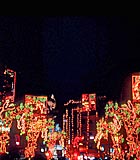 Our local Puja was of Triangular Park on Rash Behari Avenue, but in the evening I was fond of going over to Maddox Square on Ritchie Road near my school. Many of my friends lived there and the girls were said to be both numerous and prettier. Both Pujas survive to this day. In the mornings we would first go for Anjali, the ceremonial offering of flowers to the Goddess amid the chanting of Chandi, and then pandal-hopping, initially with our parents and later with friends, first in the south (Singhi Park, Samaj Sebi, 23 Pally); and then board a double-decker of route 2B (2B or not to be, went the joke) to the famous Pujas of the north: Fire Brigade, Simla Byayam Samity, Mohammed Ali Park, Santosh Mitra Square, Bagbazar, and others.
Our local Puja was of Triangular Park on Rash Behari Avenue, but in the evening I was fond of going over to Maddox Square on Ritchie Road near my school. Many of my friends lived there and the girls were said to be both numerous and prettier. Both Pujas survive to this day. In the mornings we would first go for Anjali, the ceremonial offering of flowers to the Goddess amid the chanting of Chandi, and then pandal-hopping, initially with our parents and later with friends, first in the south (Singhi Park, Samaj Sebi, 23 Pally); and then board a double-decker of route 2B (2B or not to be, went the joke) to the famous Pujas of the north: Fire Brigade, Simla Byayam Samity, Mohammed Ali Park, Santosh Mitra Square, Bagbazar, and others.
The ‘north’, including central Calcutta, was still largely unknown territory to us, and we just followed the crowd and got into some lane (aptly named Serpentine) from Lower Circular Road, to emerge unexpectedly into Amherst Street. Saugata was very fond of keeping a track of the number of pandals he visited, but I got tired easily and often stayed away from a long, snaking queue while he and the rest of our party would go in and emerge 15 minutes later, dripping with sweat and sindur, looking victorious at having added yet another feather to their cap.
Evening trips to the north were allowed only after we reached our mid-teens. They were just crowd-braving affairs, a different ambience altogether, with thousands, maybe hundreds of thousands of people aimlessly milling around in brand new clothes, some going into the main pandal, emerging; the mela next to the Puja pandal, with its garish neon lights, loudspeakers blaring, its stalls selling kitchen hardware and condiments; Papadwalas frying papad, other food vendors frying ducks’ eggs into fat omelettes that the visiting villagers would gorge on (I detested the smell); some odd stall-wallah, shouting over a worn-out mike about some gory magic show, featuring a woman with a spider’s body, and a bloody severed head that talks; and above all sounds, some puja organiser hollering away over the official public address system that a little girl called Bela has been lost, and will anyone please bring her to the puja office, and another small boy called Poncha is in the office, would his parents come forward and claim him?
Bijoya Dashami was a day of celebration, some abandoned fun and a lot of sadness. Sindur Khela by married women in the evening, then walking before the lorries all the way to the immersion, dancing and shouting and bursting crackers all the time.
If one visits the Bagbazar Puja Pandal this Puja, one would probably find the same ambience. The same crowd, the same aimless milling, the same mela with the same garish neon lights, the same announcements about lost and found children. The same fun and frolic on Bijoya, maybe some more drinking than was done back then. So what has changed? Well, several things. Let me begin with the decor.
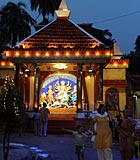 In our salad days a Durga pratima (idol) was a Durga pratima, made of conventional material like clay on a skeleton of straw, with cotton and silk fabric adorning her, some zari, some metal – that’s about all. The only variety was that in some Ma Durga and her children, Lakshmi, Saraswati, Kartik and Ganesh were each in front of an individual chalchitra (the semicircular motif forming the backdrop of the image), while in the more traditional Pujas they were all in front of one large chalchitra, the ensemble collectively called daaker saaj. And a pandal was a pandal, meant just for housing the image and the worshippers, the structure made of bamboo, swathed in cloth on the inside, covered with tarpaulin on the outside. The lighting was plain, usually a lot of fluorescent tubes, with the bigger pujas having some neon signs.
In our salad days a Durga pratima (idol) was a Durga pratima, made of conventional material like clay on a skeleton of straw, with cotton and silk fabric adorning her, some zari, some metal – that’s about all. The only variety was that in some Ma Durga and her children, Lakshmi, Saraswati, Kartik and Ganesh were each in front of an individual chalchitra (the semicircular motif forming the backdrop of the image), while in the more traditional Pujas they were all in front of one large chalchitra, the ensemble collectively called daaker saaj. And a pandal was a pandal, meant just for housing the image and the worshippers, the structure made of bamboo, swathed in cloth on the inside, covered with tarpaulin on the outside. The lighting was plain, usually a lot of fluorescent tubes, with the bigger pujas having some neon signs.
Not any more. The fashion began in the seventies of making idols of diverse materials: first rice, daal, wheat grains; then more unconventional material like bottle caps, coconut shells, electrical insulators. Those were times of scarcity, and columnist Lindsay Emerson, the last pucca sahib of The Statesman, quipped in his Calcutta Notebook that he would try to name the materials of which Durga images were not made of: then a long list, which ended with baby food, kerosene, cooking gas and electricity.
This phase seems to be largely over, replaced by a new disease called ‘theme’. The ‘theme’ could be the Mayan civilization of Mexico, or the French Revolution, or whatever. In the latter case, the image would be surrounded by likenesses of Marie Antoinette or Robespierre (who knows their faces?), among battlements supposed to be Bastille, with a Guillotine somewhere, dripping blood; and the pandal would somehow sport a likeness of the Eiffel Tower (never mind that it did not exist during the revolution, it is a symbol of France, yes or no?).
And talking of France, a tiny former French possession called Chandernagor, some 30 kilometers from Calcutta, still sporting an old gate marked “Liberté, Egalité, Fraternité” and “Republique Française” on the Grand Trunk Road, has injected a new element in the Pujas (one that I am personally very fond of), known as ‘Chandannagar lighting’.
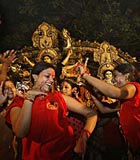 Made of absolutely pedestrian equipment (no chips, no printed circuit boards), this brand of lighting is capable of recreating coloured, moving images of practically everything – from a ballistic missile being launched, to Tagore accepting the Nobel Prize – you name it, they’ll do it. These are incredible things which can qualify as pieces of art, things that will take your breath away, fashioned by ordinary semi-literate electricians.
Made of absolutely pedestrian equipment (no chips, no printed circuit boards), this brand of lighting is capable of recreating coloured, moving images of practically everything – from a ballistic missile being launched, to Tagore accepting the Nobel Prize – you name it, they’ll do it. These are incredible things which can qualify as pieces of art, things that will take your breath away, fashioned by ordinary semi-literate electricians.
The people who throng the Puja pandals have also drastically changed in appearance. In the fifties, at least at Puja time you would see more dhoti-clad men than otherwise—plain dhotis, white or unbleached. Today you do still see dhoti-clad men, but they wear designer dhotis, maybe blue, maybe purple, with striking patterns printed on them.
And the girls—formerly the ones too young to wear a sari would try to wear one on these three days, trying, with unskilled hands, to manage the pleats all the time. Today the only ones wearing a sari are all over 40, maybe 50s, at least the ones that I get to see in our Puja pandal of Samaj Sebi Sangha.
And the organisers have changed in character. In the days gone by they used to be do-gooders or busybodies, who got extra active during these days, just for the importance. Alas, no more. Mercenary motives have entered into everything. There are whispers heard all the time of so-and-so dada having made a deal with the decorator or the ‘theme artist’.
And there is a mad rush for prizes, awards, and attempts to influence the judges. I have also heard that some organisers create artificial bottlenecks on the way to the pandals to make sure that there is always congestion and a huge standing crowd short of the pandal. No way to prove anything, of course. And now the expenses are not by chanda or subscription. Instead they are met by sponsorship. No harm in that, though.
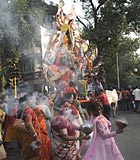 But something I miss very badly today, something that seems gone forever, was Pujor Gaan, Puja songs. They were songs of a particular genre called Adhunik Bangla Gaan, meaning ‘modern Bengali songs’, to distinguish them from songs written by famous poets such as Tagore, Kazi Nazrul Islam or Atul Prasad Sen. There were a few songwriters like Gouri Prasanna Majumdar and Pulok Bandopadhyay who excelled in these lyrics, and very catchy ones they were. But the real star attractions were the singers.
But something I miss very badly today, something that seems gone forever, was Pujor Gaan, Puja songs. They were songs of a particular genre called Adhunik Bangla Gaan, meaning ‘modern Bengali songs’, to distinguish them from songs written by famous poets such as Tagore, Kazi Nazrul Islam or Atul Prasad Sen. There were a few songwriters like Gouri Prasanna Majumdar and Pulok Bandopadhyay who excelled in these lyrics, and very catchy ones they were. But the real star attractions were the singers.
Hemanta Mukherjee (aka Hemant Kumar of Bollywood) among men and Sandhya Mukherjee and Lata Mangeshkar (yes, she had sung many memorable songs in Bengali) among women, were top slot; but Shyamal Mitra, Manabendra, Satinath, Utpala, Alpana and others were not far behind. They used to record songs specially ordered to be released just before the Pujas, and loudspeakers from Puja pandals used to blare them from morning till night.
They were incredibly popular, some of them had unforgettable lyrics and tunes, like Moner Janala Dhore Unki Mere Gechhe (Hemanta/Gouri Prasanna), and remakes of them are played to this day. We used to sit in rapt anticipation of the release and as soon as the records came out (Bakelite, 78 RPM, used to shatter if dropped), played them on windup gramophones over and over; till they became smooth and the pin started slipping between grooves, playing the same line over and over and over (what we used to call a kata record). Today’s generation have never seen 78 RPM records, nor wind-up gramophones, nor do they know what a kata record is. Not that they are missing much, though.
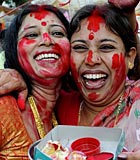 Pujas outside Kolkata were and are longer on rituals and shorter on ostentation, while those outside Bengal a different ballgame altogether. Some of these rituals were peculiar to the place—as for example, I have heard that in one Bhattacharyya family in the remote village of Baliharpur in Ghatal in Pashchim Medinipur, Durga Puja was celebrated not for three days but for eighteen.
Pujas outside Kolkata were and are longer on rituals and shorter on ostentation, while those outside Bengal a different ballgame altogether. Some of these rituals were peculiar to the place—as for example, I have heard that in one Bhattacharyya family in the remote village of Baliharpur in Ghatal in Pashchim Medinipur, Durga Puja was celebrated not for three days but for eighteen.
Financial stringency has now put a stop to many of these local rituals. Among Probashi Bangalis, that is Bengalis outside Bengal, the custom is to get together and participate in the Pujas actively, and they still do.
A few years back I visited our second home, Shillong—the pujas of Jail Road Maidan and Laban Harisabha seemed to have remained pretty much the same. Ditto for the pujas of Delhi—except maybe, Chittaranjan Park, because that place is so much like Calcutta.
One place where I am sure that Pujas have changed very drastically since the British days, is the land mass now known as Bangladesh. I have no way of knowing—they won’t give me a visa to visit, presumably because of my politics. But of course, pujas will change, as people change, so what the hell? It’s Durga Mai ki Jai, all the way, forever.
Tathagata Roy trained as an engineer. He worked with the Indian Railways and Metro Railway, Calcutta, and was later a professor at Jadavpur University. He was the president of the West Bengal unit of the BJP.

